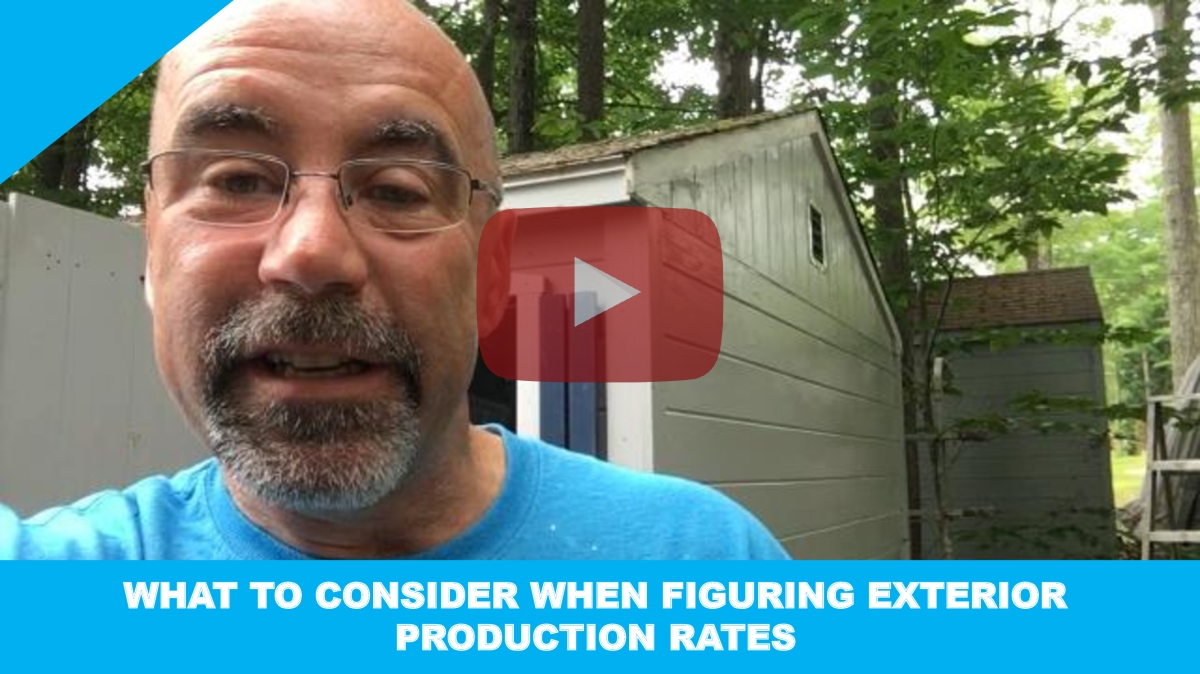
In this post, we will be talking about exterior estimating production rates and what to consider when finding your production rates.
5 Factors You Need to Consider When Figuring Your Production Rates
#1 Account For Set-Up Time and the Time Required to Clean Up the Site
Consider everything from setting up for the painting project to the very last time you pick up drop cloths.
#2 Revisit Your Production Rates Regularly
Once you have your own production rates, re-visit them periodically for accuracy.
You’ll want to do this as your crew becomes faster and when you hire on more in-experienced team members.
In the first scenario, your painters are getting much more proficient as they gain experience and as you teach them along the way which will bring your production rates up.
In the second scenario, you are bringing on new people to your team and they are going to bring the production rates down.
So, if you were bidding out jobs with a very experienced crew, but you now have 3 or 4 new people, your production rate is going to be different than it was when you had 2 or 3 people who were really experienced.
Or if you are a one-man show, the production seems to be much faster because it’s just you –get it done, get paid, move on.
Although we should be doing this, we often don’t do it. As Jim Rohn once said, “What’s easy to do, is easy NOT to do.
So, this is why I decided to measure just the side of my home as I paint it. (see video)
#3 Measure Production Rates for Each Coat of Paint Separately
We measure production rates for the first coat and second coat. The first coat drags a little bit, but the second coat goes on much smoother since you are painting off a new, fresh surface.
#4 Measure the Area after You’ve Finished Painting and Account for Interruptions
I like to measure my area after I finish painting to get my true production rates because a lot of times I will get interrupted in-between.
So, if I have a nice half-hour straight time, I can actually work on what I have to do, complete that task and use that –as long as I wasn’t interrupted.
This example has very minimal prep.
I used the dust brush to get some particles off the side of the wall – it was washed a couple of days ago, so I know it was dry.
My entire setup process was laying down a drop cloth and putting a 6-foot ladder up and that’s all I had to do.
#5 Consider the Product You Will Be Using and Method of Application
Another thing to consider is the product you are going to be using and how you are going to apply it.
Of course, if I was going to spray this whole thing, I would be done in 5 minutes, but my prep would be longer.
I would tape off the little vent, throw a drop cloth down, maybe protect something, move the truck or something like that, and that would be the setup.
I was going to back brush, I would add another couple minutes on top of that.
On this one, I used the brush because I didn’t have the roller.
It was a great task of finding out how long it was going to take using a 4-inch stain brush on this side.
The side in this example was 8 and a half feet by 12 feet, which turns out to be 102 square feet, for the first coat.
So now I have a production rate of less than a half an hour and would be 204 square feet for an hour production –great to know.
After the first coat, I would allow it to dry before adding a second coat and measure it again.
Just in case I was interrupted, I can stop my measurement and time myself with a phone. It actually took me 29 and a half minutes to paint the side of this shade with a brush. That includes putting the drop cloth off, moving the drop cloth up and down and the ladder a couple of times.
Those are just 5 things to consider when figuring out your production rates.
Why do we need production rates?
Without production rates, you are going to look at any project and say, “I can do that in this amount of time,” and no doubt you can, but did you consider the prep and your crews experience? Let’s get real numbers and get real accurate.
Guesstimating is great, but there is nothing better than the actual numbers. They’ll put real coin in your pocket.
So, if you are not measuring production rates, start. It is the only way to get exact pricing when you are putting together estimates.
What would you add to these considerations?
I hope this helped. I am Ron Ramsden, DYB Coach, if you would like to reach me, you can do so at Ron@DYBCoach.com

